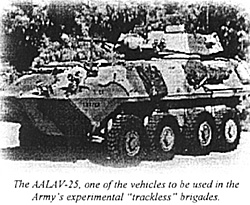 Twenty-five years ago, Jim Dunnigan and
others at SPI worked on Firefight, a simple
modern combat game pitched at the fire-team/
individual vehicle level.
Twenty-five years ago, Jim Dunnigan and
others at SPI worked on Firefight, a simple
modern combat game pitched at the fire-team/
individual vehicle level.
The AALAV-25, one of the vehicles to be used in the Army’s experimental “trackless” brigades.
The work was originally done on contract with the U.S. Army to teach its soldiers about the capabilities of the weapons they and their antagonists would use on the real battlefield. SPI worked hard on the design but the end result was less than what he had hoped. Jim writes about the experience in this excerpt from The Complete Wargames Handbook (1992 edition):
“It took a few years but eventually, with the help of a $25,000 development contract from the Army, we produced the game, called Firefight. The Army initially accepted, but ultimately dropped, Firefight for training purposes because it was "too complicated."
[Jim also alleged elsewhere that the Army insisted on game maps that featured ridiculously small amounts of ground cover and huge fields of fire, apparently to drive home to troops the long effective ranges of their tank guns and TOW missiles, though any actual combat in Germany was expected to take place at ranges of less than 500 yards -ed.]
But they did get a couple of thousand copies circulating among combat units. However, I estimate that we sold more copies of Firefight to soldiers than the Army distributed since our contract allowed us to publish it for the general public. The game was a bestseller and as of early 1992, was still in print. [Decision Games is still selling copies, if you want one - ed.]
The Firefight project was an interesting example of how the military (or, I should say, the large peacetime military organization) operates. All reports I got back from evaluators of Firefight recommended it. I spoke to one fellow who headed the evaluation team for the Fifth Corps in Germany; he said that his team's review was highly favorable.
The Army even went to the expense of rewriting the rules in a much more expanded and illustrated format. This undoubtedly cost much more than it cost us originally to do the game.
I concluded that for most training purposes, the game probably was too complicated for many potential users (senior NCOs and junior officers). Firefight required too much work to play. It should have used a computer. But computers were not yet generally available and Firefight was. However, many of those troops who were able to get a copy found it useful. At least it showed them was a manual wargame was and what it could, and could not, do for them.”
Jim now spends much of his time as a “Beltway Bandit” (although he operates, as always, from New York), doing consultancy work for the myriad agencies of the American defense industry. And one of his latest projects, Team Trackless, is a volunteer, unclassified effort to use commercial computer wargames to test new doctrine and tactics for the new "trackless" (wheeled armored vehicles) brigades the US Army is experimenting with. Team Trackless members are all wargamers, and many are wargame developers and military professionals. The purpose of Team Trackless is to see if new ideas can be tested by military professionals using off-the-shelf tools. The project is being run through Jim’s Strategy Page website. Here is the URL for the Team Trackless page, which now serves as a clearing house for tools and results for the project: http://www.strategypage.com/tt/ trackless.htm.
Jim is using the milgames listserv (see http://members.aol.com/jfdunnigan/private/ index.htm for information) to get things going, and e-mail in general to coordinate the testing. He says:
“Anyone can participate, although preference is given to those with wargaming experience, or those on active duty and likely to serve in one of the new brigades. You will need to get a copy of TacOps 3, which can be obtained at www.battlefront.com. You can also get a free demo of the game there. Contact me at jfdunnigan@aol.com and I'll put you on the list of testers. Scenario assignments will be distributed, testing reports collected and published here. We already have several army officers on the team, some of them involved with creating these new units or developing doctrine for them. These folks cannot get as involved with this project as they would like. But they do plan to use the results of our tests.”
TacOps is the simulation program most used so far, but other programs that are being considered to test the concepts for the new brigades are Steel Panthers 3, Operational Art of War II, Decisive Action (courseware at the Army staff school), and Brigade Combat Team. The latter two were designed by Marine and Army officers, and TacOps was designed by I.L. Holdridge, a retired Marine major.
Let’s hope that this project pays off for both the civilian and military sides of the equation. Ideally, Team Trackless will produce a workable organization and an effective set of tactics to use with a new weapons system that costs a fraction of the price of a battle
Back to Strategist Number 337 Table of Contents
Back to Strategist List of Issues
Back to MagWeb Master Magazine List
© Copyright 2001 by SGS
This article appears in MagWeb (Magazine Web) on the Internet World Wide Web. Other military history articles and gaming articles are available at http://www.magweb.com